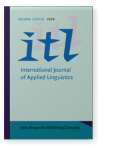Making sense in a Second Orthography
The importance of efficiently processing letters and gaining orthographic automaticity has been stressed in first language (L1) reading research. While this level has been well defined in L1 reading, it has received little attention in EFL reading, especially when the writing system in L1 differs from the one in L2. This study investigates the influence of L1 literacy and knowledge of a writing system (Farsi) on reading and processing Roman letters in English. Sixty students were selected from an Iranian university. Results showed that the students process strings of letters in Farsi and Roman script in the same way and produce upward M-shaped patterns. The findings are discussed in the light of the research for Arabic and other scripts. The implications for classroom practices in facilitating foreign language learners’ reading ability are also explored.
References
ADAMS, M.J.
(
1990) :
Beginning to Read : Thinking and Learning about Print. London : The MIT Press.

ALDERSON, J.C.
(
1984) :
Reading in a foreign language : A reading problem or a language problem? In
J.C. Alderson &
A.H. Urquhart (Eds.),
Reading in a Foreign Language. New York : Longman.

AUERBACH, E.R.
(
1993) :
Reexamining English only in the ESL classroom.
TESOL Quarterly, 27(1), 9–32.


BROWN, T. & HAYNES, M.
(
1983) :
Learning to read English as a second language : Effects of first language script systems and cultural/educational background. Michigan State University, manuscript.

CARR, T.H.
(
1985) :
The development of reading skills. New Directions for Child Development (27). San Francisco : Jossey-Bass.

CROWDER, R.G. & WAGNER, R.K.
(
1992)
The Psychology of Reading : An Introduction. Oxford : Oxford University Press.

ESKEY, D.E.
(
1988) :
Holding in the bottom : An interactive approach to the language problems of second language readers. In
P.L. Carrell,
J. Devine, &
D.E. Eskey (Eds.),
Interactive Approaches to Second Language Reading. New York : Cambridge University Press, 93–100.


GHAHREMANI-GHAJAR, S.S.
(
1994) :
Literacy practices : social and linguistic issues related to reading in a second orthography. Doctoral dissertation, Faculty of Education, University of Ottawa.

GHOLAMIAN, M.
(
1992) :
The role of orthography and cognitive factors in the concurrent development of basic reading skills in bilingual Persian-English speaking children. Master’s thesis, Graduate Department of Education, University of Toronto.

GREEN, D.W., HAMMOND, E.J, & SUPRAMANIAM, S.
(
1983) :
Letters and shapes : Developmental changes in search strategies.
British Journal of Psychology, 741,11–16.


HAYNES, M.
(
1990) :
Examining the impact of L1 literacy on reading success in a second writing system (ws2). In
H. Burinuster et al. Variability in Second Language Acquisition : Procedures of the 10th Meeting of the Second Language Research Forum, Vol. 11.

HAYNES, M. & CARR, T.H.
(
1990) :
Writing system background and second language reading : A component skills analysis of English reading by native speaker-readers of Chinese. In
T.H. Carr (Ed.),
Reading and Its Development: Component Skills Approaches. New York : Academic Press, Inc., 375–421.

JEW, V.
(
1986) :
Literacy Skills Development and the Asian LEP Students. Paper presented at the 15th Annual International Bilingual/Bicultural Education Conference of the National Association for Bilingual Education, Chicago, Illinois.

JUST, M.A. & CARPENTER, P.A.
(
1980) :
A theory of reading from eye fixations to comprehension.
Psychological Review, 871, 329–354.


KODA, K.
(
1989) :
The effects of transferred vocabulary knowledge on the development of L2 reading proficiency.
Foreign Language Annals, 22(6),529–540.


KODA, K.
(
1988) :
Cognitive process in second language reading : transfer of L1 reading skills and strategies.
Second Language Research, 4(2), 133–156.


MASON, M.
(
1982) :
Recognition time for letters and nonletters : Effects of serial position, array size, and processing order.
Journal of Experimental Psychology: Human Perception and Performance, 8(5), 724–738.

MASON, M. & KATZ, L.
(
1976) :
Visual processing of nonlinguistic strings : Redundancy effects and reading ability.
Journal of experimental psychology: General, 105(4), 338–348.


MEARA, P., COLTHEART, M., & MASTERSON, J.
(
1985) :
Hidden reading problems in ESL learners.
TESL Canada Journal, 3(3), 29–36.


ONG, W.
(
1982) :
Orality and Literacy: The Technologizing of the Word. London : Routledge.


PATEL, P.G. & SOPER, H.
(
1987) :
Acquisition of reading and spelling in a syllabo-alphabetic writing system.
Language and Speech, 30, Part 1, 69–81.


RANDALL, M.
(
1991) :
Scanning in different scripts : Does Jawi interfere with Bahasa Malaysia and English? RELC Journal, 22(2), 98–112.


RANDALL, M. & MEARA, P.
(
1988) :
How Arabs read Roman letters.
Reading in a Foreign Language, 4(2), 133–145.

RAYNER, K. & CARROLL, P.J.
(
1984) :
Eye movements and reading comprehension. In
D.E Kiers,
M.A. Just (Eds.),
New Methods in Reading Comprehension Research. London : Lawrence Erlbaum Associates Publishers, 129–150.

RAYNER, K. & POLLATSEK, A.
(
1989) :
The Psychology of Reading. New Jersey : Prentice Hall.

RYAN, A. & MEARA, P.
(
1991) :
The case of the invisible vowels : Arabic speakers reading English words.
Reading in a Foreign Language, 7,2, 531–540.

SEELY, J.
(
1992) :
On learning a second orthography. Paper presented at the 1992 AERA Conference.

TAYLOR, I.
(
1987) :
Script and reading research.
Interchange, 18(1/2), 78–88.


WALLACE, C.
(
1990) :
When a learner attempts to become literate in a second language, what is he or she attempting? TESL Talk, 20(1), 27–30.

Cited by
Cited by 1 other publications
Sima Paribakht, T. & Marie-Claude Tréville
2007.
L'inférence lexicale chez des locuteurs de français et des locuteurs de persan lors de la lecture de textes anglais : effet de la lexicalisation en première langue.
The Canadian Modern Language Review 63:3
► pp. 399 ff.

This list is based on CrossRef data as of 1 april 2024. Please note that it may not be complete. Sources presented here have been supplied by the respective publishers.
Any errors therein should be reported to them.
